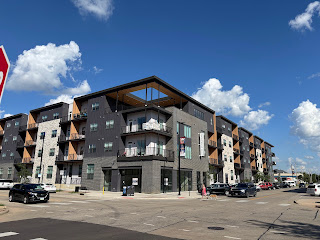 |
| Source: dimassuryo.files.wordpress.com |
From a troglodyte's perspective the world began to globalize 3000-4000 years ago as trading developed across groups and, as navigation developed, across geographic regions. But that's not what we're talking about here. Technology has increasingly enabled manufacturing, marketing and to a certain extent service provision to occur across space without noticeable impact on the product or the consumer. No more is it enough to be the best bank, car dealer or bookseller in your part of town; now you're competing with banks, or car dealers, or booksellers all over the world.
In Thomas Friedman's felicitous phrase, today's world is "flat." Without going all in on his argument, the flatness metaphor is useful for illustrating how geographic barriers to competition have been removed, which makes economic security more difficult to achieve whether one is an individual, a firm or a city. Friedman, while noting that people "have to run harder to stay in place," generally sees this as a positive development, and he's far from alone in this. Tougher competition brings more and better choices for consumers, and all those firms and workers running harder will keep improving human life. Friedman emphasizes skill development as the answer to individual and national insecurity, particularly advocating improvements to the U.S. education system.
The benefits are hard to deny: Besides offering greater choices for consumers, a flat world has allowed development of a middle class in emerging nations like China and India, and reduced the extent of poverty worldwide especially in Latin America (FAO 2015). Of course, for the winners in global competition the rewards are huge. Just ask Jeff Bezos, founder of Amazon.com, who is probably the richest bookseller the world has ever known, or the heirs of Sam Walton, who founded the most dominant retail chain in history. However, a lot of people, at least in the West, are finding that global opportunity cuts both ways, and are stressed by what seems like a loss of control over their lives (Berube). This insecurity is exacerbated by advances in automation, which allow manufacturing to be done by a fraction of the work force of days gone by; a liberal (at least in practice) immigration regime which flattens even local labor markets; and doubts about our ability to replicate the economic growth of the 20th century. (For the last point including its impact on politics and society, see Thomas Piketty, Capital in the Twenty-First Century [Harvard, 2014], ch. 2.)
What the forces of globalization, automation, immigration and slow growth have in common is that they raise questions about the future of work. The pop culture image of the blue collar working stiff slogging his way through the working day (think Johnny Paycheck's classic song "Take This Job and Shove It" or Fred Flintstone shouting "Yabba dabba do!" when the whistle blows at quitting time) seems positively blessed in retrospect. However boring, arduous or dehumanizing their jobs, that era's "blue collar aristocrats" could generally count on jobs being there for anyone able to work. If cars were going to be made, steel produced or coal mined from the Earth, large numbers of American (mostly) men were going to be needed to do it.
Previous technological advances have, of course, brought insecurity. The Luddite protests more than 200 years ago may not have been reacting to technological advances, but plenty of their contemporaries feared for their jobs in the Industrial Revolution (Conniff 2011). Eventually the descendants of the Luddites found work in mines, on railways, and in trades, joined unions and were paid reasonably well, and of course many people until relatively recently worked on farms (cf. Lebergott 1966). And maybe the answer to the future of work is just around the corner. Millions of jobs have been created since the depths of the recession in 2010, with the official U.S. unemployment rate falling from over 10 to below 5 percent. However, there's a difference between a job and a career; wages remain stubbornly stagnant and long-term unemployment persists at a high level (Kille 2014, Burtless 2016). From the perspective of 2016, the future of work remains mysterious. If the current presidential campaign is any indication, political elites have less of a clue about what to do than I do, which unfortunately is saying a lot. It's little wonder that an insecure public turns on easy targets. If only we could ditch the EU bureaucrats, environmental regulations, or large banks; if only we could raise the minimum wage, restrict immigration, or make college free; then everything could go back to the way it was. Except somehow we'd get to keep all the cool stuff.
American cities today find themselves in a variety of positions. Some continue to reel from the collapse of the industrial economy four decades ago, and are struggling to serve citizens with multiple needs, stem declines in population, and figure out some way back onto the horse that is the global economy. Others have found their places in the global economy, as centers of technology, medicine, media and the like. But even those cities have a substantial number of poor citizens the benefits aren't reaching. Cities of all types are having to come up with policy solutions when [a] they are elusive, [b] past errors have left city finances in shaky states, and [c] people everywhere--not just Britain--are skeptical of government elites who collect taxes yet seem unable to deliver satisfactory outcomes.
 |
| Source: globalizationns31.yolasite.com |
I am no libertarian. I firmly believe that the answers to the problems of the 21st century will be found through conversation, building connections and collective effort. "We're all stuck here for awhile," as Rodney King once said. They will require government in order to articulate and administer collective decisions. But I'm not surprised that a lot of people react to the 21st century by sticking it to whomever they can--elites, phantoms, and each other.
SEE ALSO: David Wessel, "In Wake of 'Brexit,' Addressing Voter Anger with More Than Lip Service," Brookings, 24 June 2016, http://www.brookings.edu/research/opinions/2016/06/24-wake-of-brexit-addressing-voter-anger-wessel
OLDER POSTS
"The 'New Normal' Economy and Place," 20 November 2013
"State of the Union and Places," 29 January 2014
"The Future of Economic Inequality," 1 October 2014
SEE ALSO: David Wessel, "In Wake of 'Brexit,' Addressing Voter Anger with More Than Lip Service," Brookings, 24 June 2016, http://www.brookings.edu/research/opinions/2016/06/24-wake-of-brexit-addressing-voter-anger-wessel
OLDER POSTS
"The 'New Normal' Economy and Place," 20 November 2013
"State of the Union and Places," 29 January 2014
"The Future of Economic Inequality," 1 October 2014












